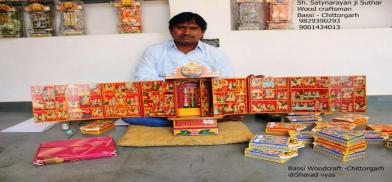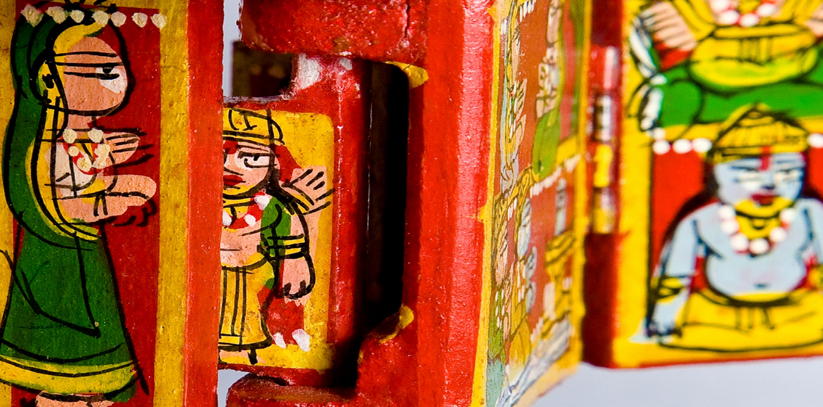Rajasthan’s Kaavad: A 400-year-old evolving tradition of storytelling
While Rajasthan has an incredibly long list of historic monuments and sites, its glory is not confined to the heritage that charts its geographical space

While Rajasthan has an incredibly long list of historic monuments and sites, its glory is not confined to the heritage that charts its geographical space. Its long-standing cultural traditions inspired certain artworks that became specific to the region - kaavad is one such example. Kaavad - or ‘chalta-firta mandir’ (travelling shrine) - this intricate wooden box has traditionally held countless stories to enthrall audiences, unraveled only by the specialised bhaats. Unfortunately, though, as is the case with many of India's indigenous arts, the ecosystem around the kaavad is in a crisis in modern times.
A lesser-known form of storytelling
This unique craft of storytelling comes from Rajasthan's Marwar district. Made of handcrafted wood, the kaavad’s structure is akin to a colourful ‘cupboard’. Its uniqueness lies in its execution with a closed panel (bund paat, on the left), an opened panel (khul paat, on the right) and a secret panel (gupt paat, behind the sliding panels), skilfully made by the suthars (carpenters) of the Mewar district. Painted with vibrant colours, its complex emblems are used by the kaavadiya bhaats (storytellers) to recite the many tales from within the same kaavad box to an enthralled audience.
The suthars are skilled in building and painting the box with such complexity that the bhaats can variate the story for the jajmans (hereditary patrons) and audiences, incorporating elements of their lives and families into the narrative - making them relatable and sought-after. In that, it allows each image to be religious, mythological, genealogical, eulogical, social, contemporary, or anything, thus, making the kaavad ‘highly inclusive’.
Thus, the carpenters and storytellers together invoke spirituality and awareness among their patrons with their craft and storytelling, respectively.

Ritual to Recreation
Over time, though, the age-old tradition of kaavad-making and kaavad baanchana have changed.
That it survived and adapted to demands of the hour was gathered in a conversation with Satyanarayan Suthar, a traditional national-award-winning kaavad-maker from Rajasthan’s Bassi village, Chittorgarh. Suthars are now customising kaavads (currently available in different colours and sizes, narrating only a single story) as collectors’ items rather than the original shrines. The new ‘altered kaavads’ thinly obscured the 12-inch traditional red kaavads, also called the ‘Madwadi kaavads’, which held the potential to narrate several stories within its limited imagery.
Unfolding pages
One of the innovations, keeping its essence intact, is the illustrated children’s book Home (published by Tulika). Home is a standing book, which can be accessed from both sides leading to a central panel (like the secret chamber of the kaavad) with a window - mirroring the way one narrates a kaavad. The book cover is lush with illustrative figures which propel storytelling, giving children a chance to weave their own story, each time different, as in the case of the traditional kaavadiya bhaats.

From homes to exhibition spaces
While earlier bhaats would go from house to house narrating their stories, now with both the art and the craft nearing disappearance, the communities of suthars and kaavadiya bhaats are struggling to make a livelihood. Kojaram Bhaat from Ramdevra village in Jaisalmer has been preserving his ancestral profession of kaavad baanchana for around 40 years, but from constantly traveling between Diwali and Holi narrating stories across villages, now he only receives a few requests for short two-hour mechanical narrations. Previously, a single panel would deserve a free-flowing narration of one-and-a-half hours. For sustenance, Kojaram and his fellow bhaats have taken to working as farmers, construction workers, etc.
However, there are a few ongoing projects that are attempting to save fragments of this craft in either the exhibition space or as performances. Thespian Akshay Gandhi’s Kaavad Project is one such example, wherein he has brought kaavad baanchana on to the stage. The project’s site explains: ‘Kaavad Katha – Maya’ is a collaboration between theatre artistes, visual artists and illustrators, musicians, a movement artiste, and a mask maker, bringing Rajasthan’s lost form of Kaavad katha to the proscenium stage with life-size paintings, live and original music, original stories in poetry and a solo performer.
In addition, suthars of Bassi village have attempted to retain the (original) structure of the kaavad as miniaturised souvenirs, toys, and decorative pieces for tourists and children. Satyanarayan Suthar has held several exhibitions and has sold his work online, both in India and abroad. His kaavads range from six inches to 12 feet.
That this 400-year-old tradition of storytelling is on its swan song is no secret, but by figuring out different ways to keep the narrative alive, some elements of this unique craft will at least be around for future generations to see and experience.
(This article is part of Saha Sutra on www.sahapedia.org, an open online resource for Indian arts, cultures and heritage)









Post a Comment